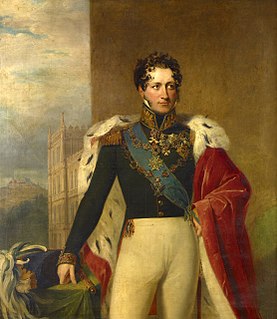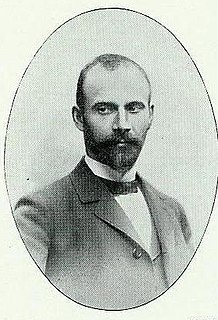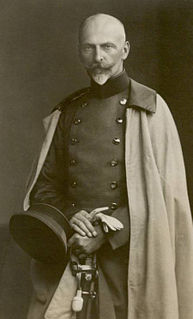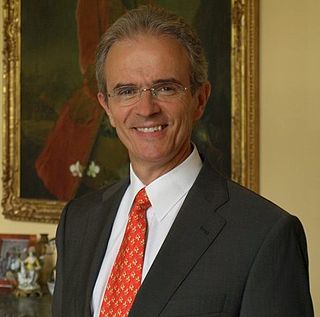
Saxe-Coburg and Gotha, or Saxe-Coburg-Gotha, was an Ernestine, Thuringian duchy ruled by a branch of the House of Wettin, consisting of territories in the present-day states of Thuringia and Bavaria in Germany. It lasted from 1826 to 1918. In November 1918, Charles Edward, Duke of Saxe-Coburg and Gotha, was forced to abdicate. In 1920, the northern part of the duchy was merged with six other Thuringian free states to form the state of Thuringia: Saxe-Weimar-Eisenach, Saxe-Altenburg and Saxe-Meiningen, Schwarzburg-Rudolstadt and Schwarzburg-Sondershausen, as well as the People's State of Reuss. The southern part of the duchy, as southernmost of the Thuringian states, was the only one which, after a referendum, became part of Bavaria.

Ernest I was the last sovereign duke of Saxe-Coburg-Saalfeld and, from 1826, the first sovereign duke of Saxe-Coburg and Gotha. He was the father of Albert, Prince Consort, who was the husband of Queen Victoria. Ernest fought against Napoleon Bonaparte, and through construction projects and the establishment of a court theatre, he left a strong imprint on his residence town, Coburg.

Prince Frederick Josias of Saxe-Coburg-Saalfeld was an Austrian nobleman and military general.

The House of Wettin is a dynasty of German counts, dukes, prince-electors and kings that once ruled territories in the present-day German states of Saxony, Saxony-Anhalt and Thuringia. The dynasty is one of the oldest in Europe, and its origins can be traced back to the town of Wettin, Saxony-Anhalt. The Wettins gradually rose to power within the Holy Roman Empire. Members of the family became the rulers of several medieval states, starting with the Saxon Eastern March in 1030. Other states they gained were Meissen in 1089, Thuringia in 1263, and Saxony in 1423. These areas cover large parts of Central Germany as a cultural area of Germany.

Saxe-Altenburg was one of the Saxon duchies held by the Ernestine branch of the House of Wettin in present-day Thuringia. It was one of the smallest of the German states with an area of 1323 square kilometers and a population of 207,000 (1905) of whom about one fifth resided in the capital, Altenburg. The territory of the duchy consisted of two non-contiguous territories separated by land belonging to the Principality of Reuss. Its economy was based on agriculture, forestry, and small industry. The state had a constitutional monarchical form of government with a parliament composed of thirty members chosen by male taxpayers over 25 years of age.

Saxe-Meiningen was one of the Saxon duchies held by the Ernestine line of the Wettin dynasty, located in the southwest of the present-day German state of Thuringia.

Saxe-Coburg was a duchy held by the Ernestine branch of the Wettin dynasty in today's Bavaria, Germany.

Saxe-Coburg-Saalfeld was one of the Saxon Duchies held by the Ernestine line of the Wettin Dynasty. Established in 1699, the Saxe-Coburg-Saalfield line lasted until the reshuffle of the Ernestine territories that occurred following the extinction of the Saxe-Gotha line in 1825, in which the Saxe-Coburg-Saalfeld line received Gotha, but lost Saalfeld to Saxe-Meiningen.

Andreas, Prince of Saxe-Coburg and Gotha, Duke of Saxony has been the head of the House of Saxe-Coburg and Gotha since 1998. He is the grandson of Charles Edward, the last ruling duke of Saxe-Coburg and Gotha.

Frederick III, Duke of Saxe-Gotha-Altenburg, was a duke of Saxe-Gotha-Altenburg.

Frederick IV, Duke of Saxe-Gotha-Altenburg, was the last duke of Saxe-Gotha-Altenburg.

Ernst, Prince of Saxe-Meiningen was the head of the house of Saxe-Meiningen from 1928 until his death.

Prince Friedrich of Saxe-Meiningen, Duke of Saxony was a German soldier and member of the Ducal House of Saxe-Meiningen.
Bernhard, Prince of Saxe-Meiningen was the head of the House of Saxe-Meiningen from 1946 until his death.

Alexander, Prince of Saxe-Gessaphe, is the adopted son and heir of Maria Emanuel, Margrave of Meissen, and a businessman with Lebanese, Mexican, Polish and German roots. Following the death of Maria Emanuel in July 2012 he assumed the headship of the Royal House of Saxony, based on a 1997 agreement that named him heir, but which was repudiated a few years later by a number of signatories. His claim is disputed by his cousin Prince Rüdiger of Saxony.

Elisabeth Sophie of Saxe-Altenburg, was a princess of Saxe-Altenburg and, by marriage, duchess of Saxe-Gotha.
Prince Rüdiger Charles Ernest Timo Aldi of Saxony, Duke of Saxony, Margrave of Meissen is a disputed head of the Royal House of Saxony, and the only agnatic great-grandson of the last King of Saxony, Frederick Augustus III.
Ernst Leopold Eduard Wilhelm Josias Prinz von Sachsen-Coburg und Gotha was the second child and eldest son of Johann Leopold, Hereditary Prince of Saxe-Coburg and Gotha and Feodora Freiin von der Horst.
Hubertus Prinz von Sachsen-Coburg und Gotha is the eldest son of Ernst-Leopold Prinz von Sachsen-Coburg und Gotha and his first wife, Ingeborg Henig.














